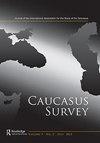《以牙还牙:了解俄罗斯与北约在东欧的互动》
IF 0.5
Q3 AREA STUDIES
引用次数: 0
摘要
本文分析了北大西洋公约组织-俄罗斯在东欧的动态,重点关注格鲁吉亚和黑山的影响力竞争,并将其与摩尔多瓦和乌克兰进行比较。尽管这四个国家都表达了加入北约的愿望——俄罗斯一直表示不赞成——但莫斯科却采取了不同的方式来遏制北约的扩张,并以针锋相对的策略升级。我们认为,俄罗斯是否部署军事战略、经济杠杆、政治战术或秘密行动,根据其相对的力量投射能力以及北约和目标国家的反应而有所不同。在毗邻的地理位置(格鲁吉亚、乌克兰)使力量投射能力更强的地方,俄罗斯进行军事干预;在实力较弱的地方,在非毗邻的国家(黑山、摩尔多瓦),俄罗斯采取非军事手段。俄罗斯可能一致反对北约东扩,但其将邻国排除在北约之外并置于俄罗斯轨道内的战略取决于其相对实力。本文章由计算机程序翻译,如有差异,请以英文原文为准。
“Tit-for-Tat:” Understanding Russia – NATO Interactions in Eastern Europe
Abstract This article analyzes North Atlantic Treaty Organization ( NATO ) – Russia dynamics in Eastern Europe, focusing on the competition for influence in Georgia and Montenegro with comparisons to Moldova and Ukraine. Whereas all four countries have expressed a desire to join NATO – and Russia has consistently communicated its disapproval – Moscow has pursued divergent means to curb NATO expansion and escalated with tit-for-tat strategies. We argue that whether Russia deployed military strategies, economic levers, political tactics or covert actions has varied according to its relative power projection capacity along with the responses of NATO and the target countries. Where power projection capacity is greater due to its contiguous geography (Georgia, Ukraine), Russia staged military interventions, and where it was weaker, in non-contiguous countries (Montenegro, Moldova), it resorted to non-military means. Russia may be uniformly opposed to NATO expansion, but its strategies to keep its neighbours out of NATO and in Russia’s orbit are contingent upon its relative power.
求助全文
通过发布文献求助,成功后即可免费获取论文全文。
去求助
来源期刊

Caucasus Survey
Arts and Humanities-History
CiteScore
1.30
自引率
9.10%
发文量
4
期刊介绍:
Caucasus Survey is a new peer-reviewed, multidisciplinary and independent journal, concerned with the study of the Caucasus – the independent republics of Armenia, Azerbaijan and Georgia, de facto entities in the area and the North Caucasian republics and regions of the Russian Federation. Also covered are issues relating to the Republic of Kalmykia, Crimea, the Cossacks, Nogays, and Caucasian diasporas. Caucasus Survey aims to advance an area studies tradition in the humanities and social sciences about and from the Caucasus, connecting this tradition with core disciplinary concerns in the fields of history, political science, sociology, anthropology, cultural and religious studies, economics, political geography and demography, security, war and peace studies, and social psychology. Research enhancing understanding of the region’s conflicts and relations between the Russian Federation and the Caucasus, internationally and domestically with regard to the North Caucasus, features high in our concerns.
 求助内容:
求助内容: 应助结果提醒方式:
应助结果提醒方式:


